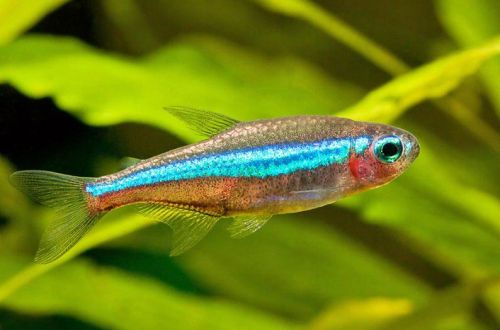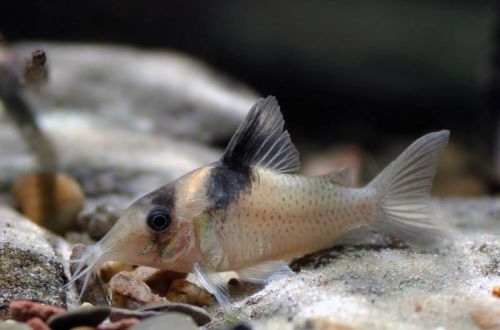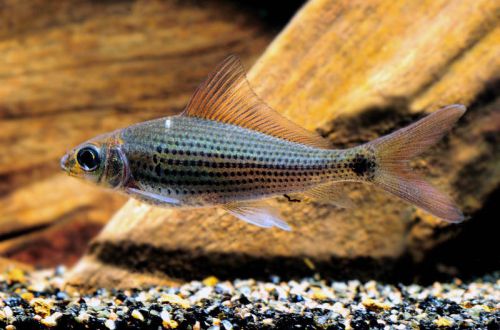
False neon
False Blue Neon, scientific name Paracheirodon simulans, belongs to the Characidae family. Rarely found on sale in comparison with other Neons, although they are not inferior to them in the brightness of color and simplicity of maintenance.

Contents
Habitat
Comes from South America from the upper and middle basin of the Rio Negro (Amazonaz, Brazil). The natural habitat is characterized by a large amount of dissolved tannins, from which the water acquires a rich brown hue. A typical biotope includes dense coastal vegetation hanging over the surface, sandy substrates covered with a layer of fallen leaves, and numerous snags. The fish live in dim light conditions due to the dark water and the shade of dense tree crowns.
Brief information:
- The volume of the aquarium – from 40 liters.
- Temperature – 25-31°C
- Value pH — 3.0–6.5
- Water hardness – 1–9 dGH
- Substrate type – any
- Lighting – subdued
- Brackish water – no
- Water movement is weak
- The size of the fish is about 2 cm.
- Feeding – any food of suitable size
- Temperament – peaceful
- Keeping in a group of 8-10 individuals
Description
Outwardly, it resembles its close relative Blue Neon, but unlike it, it is somewhat smaller in size (about 2 cm) and has a less pronounced red stripe, often blue colors dominate in color. If it had been discovered earlier, then the prefix “false” would have received the usual Neon known to us.
Sexual dimorphism is weakly expressed, males and females are practically indistinguishable. The latter may be slightly larger in the spawning state.
Food
Accepts most popular foods of a suitable size, such as dry flakes, pellets, live or frozen daphnia, brine shrimp, small bloodworms, etc. The daily diet may consist exclusively of dry / freeze-dried foods, provided that foods are used from well-known and proven manufacturers .
Maintenance and care, arrangement of the aquarium
A flock of 8-10 fish can be content with an aquarium of 40 liters. The fish will look harmonious in an environment reminiscent of its natural habitat – among dense aquatic vegetation and many snags in subdued lighting conditions.
An important part of the design will be the leaves of some trees that cover the sandy bottom. By analogy with the processes occurring in natural reservoirs, during decomposition, the leaves release tannins, giving the water a characteristic brown color. In addition, these substances have antifungal and antibacterial action, which serves as an excellent prophylactic.
Successful long-term maintenance of False Blue Neon depends on maintaining stable water conditions within an acceptable temperature and hydrochemical range. The achievement of this goal is ensured by installing the necessary equipment and carrying out mandatory procedures for maintaining the aquarium. The latter include weekly replacement of part of the water with fresh water, checking it for pH and dGH to the desired values and for the presence of dangerous concentrations of nitrogen cycle products (ammonia, nitrites, nitrates), regular removal of organic waste (feed leftovers, excrement), etc. .
Behavior and Compatibility
A peaceful schooling fish, it gets along well with other peaceful species of comparable size. It is advisable to maintain the size of the group at least 8–10 individuals; with a smaller number, the already timid Neons become overly shy.
Breeding / breeding
Like other Tetras, the False Blue Neon breeds by scattering eggs throughout the aquarium, without much of a mess. Parental instincts are not developed, the fish do not care about their offspring, and on occasion they will definitely eat their own caviar and fry. To preserve the brood, fertilized eggs are placed in a separate tank.
In an artificial environment, spawning can occur throughout the year without pronounced seasonality, so in a large flock, one or more females will constantly be in a spawning state.
Fish diseases
Diseases inherent in this particular species of fish were not noted. When kept in suitable conditions (high water quality, balanced diet, non-conflict neighbors, etc.), health problems are not observed. The most common cause of disease is the deterioration of conditions leading to immune suppression, which makes the fish susceptible to infections that are invariably present in the surrounding area. When the first signs of an illness are detected (lethargy, exhaustion, refusal of food, lowered fins, etc.), it is necessary to immediately check the main parameters of the water. Often, the restoration of acceptable living conditions contributes to self-healing, but if the fish is too weak or has received obvious damage, medical treatment will be required. For more information on symptoms and treatments, see the Aquarium Fish Diseases section.





